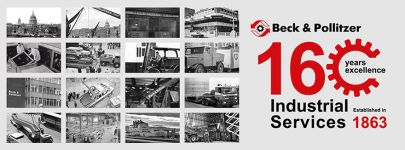News
Key steps for a successful machinery installation

Machinery installation is a critical process that involves setting up industrial equipment and machinery to ensure their proper functioning within a facility. It requires careful planning, expertise, and adherence to safety guidelines to guarantee both the safety of personnel and the longevity of the equipment. In this article, we will break down the essential steps involved in the machinery installation process, highlighting safety measures and best practices to follow.
What is machinery installation?
Machinery installation is the process of assembling, positioning and configuring industrial machinery and equipment within a designated area. This process involves various technical tasks, including aligning components, connecting power sources, and ensuring that all parts work harmoniously to achieve optimal performance.
What is the procedure for machinery installation?
A successful machinery and equipment installation involves a series of well-defined steps that need to be executed meticulously. Here’s a breakdown of the key stages:
Step 1: Planning and Preparation
Before any physical work begins, a comprehensive project plan should be established. This includes assessing the installation site, reviewing equipment specifications, and identifying potential challenges. Safety measures should be outlined at this stage to minimize risks during installation.
Step 2: Site Preparation
Clear the installation site of any obstructions and ensure that the area is clean and well-organized. Adequate space should be allocated for machinery components, taking into consideration factors such as access for maintenance and ventilation.
Step 3: Unloading and Transport
Carefully unload the machinery from transportation vehicles and move it to the installation site using appropriate lifting equipment. Follow proper lifting techniques and use certified lifting gear to prevent accidents.
Step 4: Assembly and Alignment
Assemble the machinery components according to the manufacturer’s instructions. Precise alignment is crucial for smooth operation. Laser alignment tools can be used to ensure accurate positioning.
Step 5: Connection and Integration
Connect power sources, hydraulic systems, and other necessary components as specified in the equipment’s documentation. Check for proper wiring and ensure all connections are secure.
Step 6: Testing and Calibration
Thoroughly test the machinery’s functions, ensuring that all moving parts operate smoothly. Calibrate sensors, controllers, and other instruments to guarantee accurate readings and optimal performance.
What are the responsibilities of an installer of machinery and equipment?
The machine installer holds a critical role in the installation process, encompassing various responsibilities:
Expertise: Installers should have a deep understanding of the machinery they are working with, including its technical specifications and operational requirements.
Safety: Ensuring the safety of all personnel involved is paramount. should adhere to safety protocols, wear appropriate personal protective equipment (PPE), and conduct regular safety assessments.
Precision: Machinery installers must demonstrate precision and attention to detail during alignment, assembly, and connection tasks. Small errors during installation can lead to significant operational problems later on.
Documentation: Keep thorough records of the installation process, including measurements, configurations, and test results. Proper documentation facilitates troubleshooting and maintenance in the future.
Communication: Effective communication with the client, equipment manufacturers, and other stakeholders is essential to ensure a smooth installation process.
Machinery installation is a complex process that requires careful planning, technical expertise, and a strong commitment to safety. By following the key steps outlined in this article, installers can ensure that industrial machinery installations are set up for optimal performance and longevity.
Discover how Beck & Pollitzer can assist in ensuring safe and efficient machine installations
With a remarkable history spanning over 160 years, Beck & Pollitzer has continuously evolved to meet the dynamic machinery requirements of diverse industries. As pioneers in the field, we offer a comprehensive array of machinery installation services that encompass the installation and removal of production machinery, industrial plants, and mechanical infrastructure.
Beyond our unparalleled proficiency in installation, Beck & Pollitzer’s adept teams of Project Managers, Millwrights, Riggers, and Electricians possess a wealth of experience, enabling them to deliver successful projects across the globe. Our expertise extends not only to installation but also to machinery shifting and commissioning of complex CNC-controlled equipment.
With over 30 locations worldwide and a team proficient in more than 31 languages, Our global reach is complemented by a commitment to health and safety standards that underpin our zero-accident culture. When partnering with us, our clients receive more than just machinery installation; they benefit from a legacy of excellence built on a foundation of precision, reliability, and dedication. Reach out to your nearby office today to inquire about how we can support your upcoming installation project.

